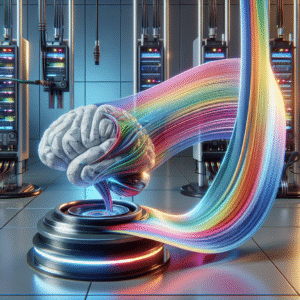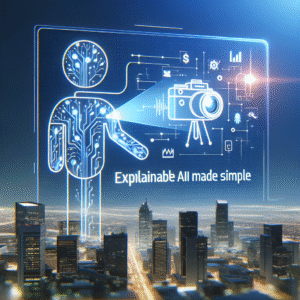Unlocking the Black Box: A Step-by-Step Guide to Explainable AI Made Simple
Table of Contents
- 1. Introduction
- 2. What is Explainable AI?
- 3. Why is Explainable AI Important?
- 4. Key Concepts of Explainable AI
- 5. Approaches to Explainable AI
- 6. Practical Applications of Explainable AI
- 7. Step-by-Step Guide to Implementing Explainable AI
- 8. Challenges and Limitations of Explainable AI
- 9. The Future of Explainable AI
- 10. Conclusion
1. Introduction
Imagine a world where the decisions made by artificial intelligence (AI) are as clear as day. Sounds nice, right? A recent survey revealed that about 80% of AI users are clamoring for more transparency in these systems. This just goes to show how important Explainable AI (XAI) has become—a field dedicated to making AI more understandable for all of us. As AI finds its way into critical areas like healthcare, finance, and criminal justice, the need for this transparency grows stronger.
Now, I know what you might be thinking: Explainable AI sounds pretty technical, maybe even reserved for the experts. But don’t worry! This blog post is here to break it down in a way that’s easy to digest. By exploring the various components and real-world applications of XAI, you’ll come away with practical insights that you can apply in your work or projects. Whether you’re a business leader, a developer, or just a curious mind about AI, this guide will arm you with the knowledge to navigate the fascinating world of Explainable AI.
2. What is Explainable AI?
At its core, Explainable AI refers to methods and techniques that aim to make AI systems more understandable by humans. Unlike traditional AI models, which can feel like impenetrable “black boxes,” XAI works to shine a light on how decisions are made. The aim is to help us understand the “why” behind AI predictions or classifications.
2.1 Defining Explainability
So, what do we mean by explainability? Essentially, it’s about how well an outside observer can grasp the reason behind a decision made by an AI system. It’s not just about what the AI decided; it’s also about why it made that choice, presented in a way that’s easy for everyone—especially non-experts—to understand.
2.2 The Evolution of Explainable AI
The journey of Explainable AI has been quite a ride over the last decade. Early on, AI models, particularly those using deep learning, faced a lot of criticism for being opaque. That’s when researchers got to work, developing techniques to unravel the mysteries of these black-box models, leading to the birth of XAI as a unique area of study.
3. Why is Explainable AI Important?
Let’s not kid ourselves—the importance of Explainable AI is massive. As AI systems weave their way into fundamental aspects of our lives, understanding how these systems make decisions is essential.
3.1 Trust and Accountability
If we want people to trust AI systems, they need to understand them. Explainability builds that trust. Imagine an AI helping diagnose health issues; knowing how the AI reached a conclusion is crucial not just for accountability but also for comfort in the decision-making process.
3.2 Regulatory Compliance
On another front, regulatory bodies are starting to demand transparency from AI systems. Take the European Union’s General Data Protection Regulation (GDPR), which includes rules that require companies to explain the logic behind automated decisions. In this landscape, Explainable AI becomes a key player in helping organizations stay compliant while using AI ethically.
4. Key Concepts of Explainable AI
To really grasp Explainable AI, it helps to know some of the key concepts involved.
4.1 Interpretability vs. Explainability
First off, let’s talk about interpretability. This term refers to how much a human can understand why an AI model made a certain decision. On the other hand, explainability is broader—it’s not just about understanding; it’s about communicating complex AI behavior in a way that anyone can wrap their head around. Grasping this difference is essential for creating effective XAI systems.
4.2 Types of Explainability
When we dive into explainability, we encounter two major types: global and local. Global explainability gives us a bird’s-eye view of how a model behaves across the entire dataset, while local explainability zooms in on specific predictions or decisions. Both play a vital role in helping us make sense of AI systems.
5. Approaches to Explainable AI
Now let’s explore some approaches to achieve explainability in AI systems.
5.1 Model-Specific Approaches
Some models are simply easier to interpret than others. For instance, think about decision trees and linear regression—they’re pretty straightforward and give clear insights into how predictions are made. On the flip side, more complex models like neural networks often need extra techniques to clarify their outputs.
5.2 Post-Hoc Explanation Techniques
Post-hoc explanation techniques come into play after a model has been trained. They help us analyze the model’s behavior and shed light on its decision-making process. Methods like LIME (Local Interpretable Model-agnostic Explanations) and SHAP (SHapley Additive exPlanations) are popular options, offering localized explanations for specific predictions.
6. Practical Applications of Explainable AI
Believe it or not, Explainable AI has a wide range of practical applications across different fields.
6.1 Healthcare
In the healthcare sector, Explainable AI can be a game-changer for diagnosing illnesses. Imagine an AI predicting patient outcomes; it can point out the factors that influenced its recommendations, empowering healthcare professionals to make informed choices.
6.2 Finance
When it comes to finance, transparency is key—especially in areas like credit scoring and fraud detection. Explainable AI can break down why a loan application was accepted or rejected, helping customers better understand the decisions that affect their lives.
7. Step-by-Step Guide to Implementing Explainable AI
If you’re looking to implement Explainable AI, here’s a simple, structured approach to ensure your AI systems are as transparent as they can be.
7.1 Define Objectives
Start by clarifying your AI system’s objectives. What decisions will it support, and who are the stakeholders? Knowing your end-users’ needs will help you design the right explainability features.
7.2 Choose the Right Model
Selecting the right model makes a big difference when it comes to explainability. If interpretability is a top priority, consider models like decision trees or logistic regression instead of diving straight into complex neural networks. For those heavier models, think about adding post-hoc explanation techniques.
7.3 Develop Explanation Methods
Once you’ve got your model sorted, it’s time to develop methods for explaining its predictions. You might use tools like LIME or SHAP for post-hoc explanations. Just remember: tailor these explanations to your end-users, making sure the info is clear and actionable.
7.4 Validate and Iterate
After implementation, it’s crucial to validate your explainability methods with real users. Gather feedback to see how well your explanations connect with them. Use this insight to iterate and improve the explanation features, making them even more user-friendly.
8. Challenges and Limitations of Explainable AI
Even with all its benefits, Explainable AI isn’t without its hurdles.
8.1 Balancing Accuracy and Explainability
One major challenge is finding the right balance between accuracy and explainability. Sometimes, complex models can achieve higher accuracy but at the cost of clarity. It’s all about striking the right chord for practical applications.
8.2 Complexity of Explanations
Crafting explanations that are both accurate and easy to understand can be tricky. If you throw around too much technical jargon or overly complex phrasing, you risk alienating your audience. Getting the tone just right is essential for effective communication.
9. The Future of Explainable AI
The outlook for Explainable AI is bright, with ongoing research aimed at creating more advanced models and explanation techniques. As the call for transparency in AI systems grows louder, organizations will likely give greater emphasis to explainability in their AI strategies.
9.1 Emerging Technologies
New technologies, like explainable reinforcement learning and interpretable deep learning, are paving the way for even more sophisticated XAI solutions. These innovations aim to enhance the interpretability of complex models while keeping their predictive power intact.
9.2 Integration with Ethical AI
Explainable AI is increasingly seen as a cornerstone of ethical AI practices. As companies work towards ensuring fairness, accountability, and transparency in their AI systems, XAI will be vital in reaching these goals.
10. Conclusion
In today’s world, Explainable AI is no longer just a nice-to-have; it’s essential for building trust, accountability, and ethical technology usage. By getting a grip on XAI principles and implementing them through a structured approach, organizations can make AI decision-making more transparent. As we step into a future dominated by AI, embracing explainability will be key to fostering positive relationships between humans and machines. For businesses looking to use AI responsibly, prioritizing Explainable AI is a vital step toward a more transparent and trustworthy technological future.
If you’re eager for more insights on how to implement Explainable AI in your organization, feel free to reach out or share your thoughts in the comments below!






